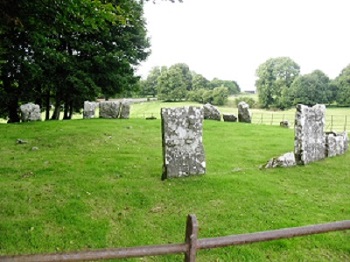
Stone circles, or stone rings (as some are not exactly circular), are perplexing archaeological monuments in the Irish countryside. They usually consist of an arrangement of free-standing-stones placed erect in the ground to form a circle with an enclosed open area. The entrance is generally in the north-east between a pair of tall matching stones known as portals. The smallest stone, called a recumbent stone, is normally the lowest of the perimeter and located opposite the entrance. Some sites are erected into earthen banks. Stone circles are mainly late Neolithic or Bronze Age monuments (c.3000 – 600 BC), once used for a multiplicity of purposes, including ceremonial, ritual, meeting places, trading sites, and burials. The main axis in some stone circles is orientated towards the rising or setting sun on specific days of the year like the summer and winter solstices. They are also believed to have been used for astronomical purposes, and could have had a role in the calendar of the ancient farming community.
There are approximately 200 surviving in Ireland, with two big concentrations, South According to the late Dr Seán Ó Nualláin, the number of stones in the Munster circles Munster and mid-Ulster. The Munster stone circles are located in County Cork, especially the Beara Peninsula, and in south Kerry. The number of stones here vary from five to nineteen, with the circle diameter on average from 7m to 10m, but some are much larger. Some circles contain boulder burials, usually cremated burials under small capstones measuring about 2m by 1m placed on low supporting stones. The best-stone circles in Cork are those near Glandore, between Skibbereen and Clonakilty. There are concentrations in Counties Fermanagh, Derry and Tyrone, with Beaghmore complex, N-W of Cookstown, and Aughlish in Derry the best known. Some circles here have more than 20 stones, with many sites containing multiple rings to add further intrigue.
There are scattered examples of stone circles in several other counties like Grange at Lough Gur in Limerick, where one circle has 113 stones and a diameter of 45m; Newgrange, County Meath, Kildare-Wicklow border, Louth, Carrowmore in Sligo, and Masonbrook, near Loughrea, in Galway.
There are twenty-four stone circles in County Mayo. An impressive collection can be seen in close proximity in Glebe, Nymphsfield and Tonaleeaun, near Cong, in the south of the county. Sometimes a stone stands outside, associated with, but not part of the circle, as at Dooncarton, near Pollatomish, in north-west Mayo. Other stone circles are located at Gortbrack North, Letterbeg, and Knocknalower, west of Glenamoy in the north-west; at Rathfran, near Killala; at Knockfarnagh on the west coast of Lough Conn, and on Achill Island.
